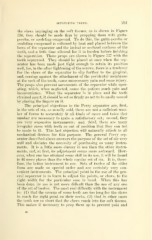Page 553 - My FlipBook
P. 553
SEPARATING TEETH. 261
the claws impinging on tlie soft tissues, as is shown in Figure
336, they should be made firm by propping them with gutta-
percha, or modeling compound. To do this, the gutta-percha or
modeling compound is softened by heat and placed l)etween the
bows of the separator and the incisal or occlusal surfaces of the
teeth, and a little time allowed for it to harden before finishing
the separation. These props are shown in Figure 337 with the
teeth separated. They should be placed at once when the sep-
arator has been made just tight enough to retain its position
well, for, in the after tightening of the screws, there is a tendency
for the claws of the separator to slip farther to the gingival,
and, coming against the attachment of the peridental membrane
at the neck of the tooth, cause unnecessary pain and some injury.
The props also prevent movements of the separator while oper-
ating, which, when neglected, cause the patient much ]iain and
inconvenience. When the separator is in place and the teeth
strained apart, it should be set so firmly as not to be easily moved
by placing the fingers on it.
The i^rincipal objections to the Perry separator are, first,
in the sets of six, as usually sold, there are not a sufficient num-
ber of forms to accurately fit all kinds of cases and twice that
number are necessary to make a satisfactory set; second, they
are very expensive instruments ; and, third, there are many
irregular cases with teeth so out of position that they can not
be made to fit. This last objection will naturally attach to all
mechanical devices for this purpose. The general Perry sep-
arator described above answers the purpose of the set of six very
well and obviates the necessity of purchasing so many instru-
ments. It is a little more clumsy in use than the other instru-
ments, and, at first, its adjustment seems more awkward. How-
ever, when one has attained some skill in its use, it will be foimd
to fit more places than the whole regular set of six. It is, there-
fore, the better instrvunent to use. Sets of twelve of the older
form are made on special order and are certainly very con-
venient instruments. The principal point in the use of the gen-
eral separator is to learn to adjust the points, or claws, to the
right width for the particular case in hand. When this has
been done, its use is not more difficult than the use of any one
of the set of twelve. The most real difficulty with the instrument
is: (1) that the crowns of some teeth are too long for the claws
to reach the right point on their necks, (2) that in other cases
the teeth are so short that the claws reach into the soft tissues.
This makes it necessary to prop them up to prevent pain and
36


